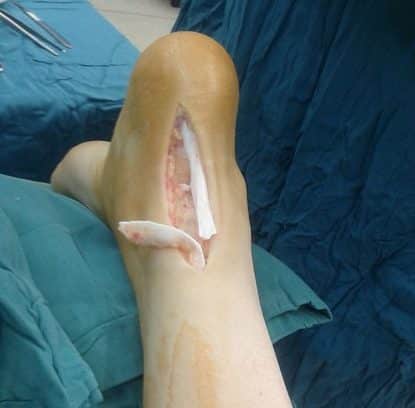Introduction
Achilles tendonitis is inflammation of the Achilles (calcaneal) tendon. It affects around 2 adults per 1000 population, however is more prevalent in those who engage in high-intensity activities which chronically overload the tendon, such as running and jumping.
Achilles tendonitis lead to Achilles tendon rupture, whereby the tendon ruptures and resulting in complete loss of function of the ipsilateral calf muscle. Approximately 80% of all ruptures occur during athletic activity.
In this article, we shall look at the pathophysiology, clinical features, and management of both Achilles tendonitis and tendon rupture.
Pathophysiology
The Achilles tendon unites the gastrocnemius, soleus, and plantaris muscles. It inserts in to the calcaneus and produces plantarflexion of the ankle.
Repetitive action of the tendon results in microtears leading to localised inflammation. Over time the tendon becomes thickened, fibrotic, and loses elasticity with repeated episodes.
Achilles tendon rupture occurs when a substantial sudden force is applied across the tendon, often in the context of existing Achilles tendonitis. The precipitating event could be a movement such as a sudden jump or rapid change in direction whilst running.
Risk Factors
The classical case of tendonitis or rupture occurs in an unfit individual who has a sudden increase in exercise frequency. Other risk factors include poor footwear choice, male gender, obesity, or recent fluoroquinolone use (for tendon rupture).
Clinical Features
Tendonitis
Achilles tendonitis presents with a gradual onset of pain and stiffness in the posterior ankle, often worse with movement. This can usually be improved with physiotherapy or heat application.
On examination, there is tenderness over the tendon on palpation (usually worse 2-6cm above its insertion site), with pressure over the tendon with your fingers reproducing this pain.
Rupture
In cases of tendon rupture, patients will often describe sudden-onset severe pain in the posterior calf, accompanied with an audible popping sound and a feeling that something “went”.
On examination, there will be a marked loss of power of ankle plantarflexion (the peroneal tendons contribute to plantarflexion so this movement remains, but significantly weakened).
The most commonly used indicators of a clinical tendon rupture are Simmonds test (below) and a palpable “step” in the Achilles tendon.

Figure 2 – Achilles tendon rupture, demonstrating complete loss of plantarflexion at the ankle
Simmonds’ Test
Simmonds’ test can be used to assess for potential Achilles tendon rupture. With the patient kneeling on a chair, with the affected ankle hanging off the edge of the chair, squeeze the affected calf. If the Achilles tendon is in continuity, the foot will plantarflex; however, plantarflexion is absent when the tendon is ruptured.
Differential Diagnosis
The main differential diagnoses to consider include Achilles tendonitis is ankle sprain, calcaneal fracture, tibial fracture, or ankle osteoarthritis. For tendon rupture, the main differential diagnoses are ankle fracture or ankle sprain.
Investigations
Both Achilles tendonitis and tendon rupture are typically clinical diagnoses; however, where there is clinical equipoise, an ultrasound scan may be required. This is particularly useful to differentiate complete and partial tears.
Management
Tendonitis
Acute tendonitis can be treated with supportive measures. Patients are encouraged to stop the precipitating exercise, ice the area, and use anti-inflammatory medication regularly.
Cases of chronic tendonitis require rehabilitation and physiotherapy; slow controlled movement against resistance has been shown to increase long term tendon strength and reduced rates of recurrent tendonitis.
Rupture
Initial management for acute partial-thickness or full-thickness Achilles tendon rupture (<2 weeks) requires analgesia and immobilisation, with the ankle splinted in a plaster in full equinus* (i.e. with the ankle and toes maximally pointed). They are then provided with crutches and not allowed to weight bear.
*It is worth noting that more units are now switching from plaster immobilisation to using a weight-bearing orthosis (a ‘moonboot’), with a large heel raise insert; this achieves the same position as described above (equinus), but the patient can fully weight bear immediately
This position is held for 2 weeks. Following this, the ankle is brought in to ‘semi-equinus’, and held for a further 4 weeks. After this, the ankle is brought in to the neutral position and held again for 4 weeks.
Delayed presentations (>2 weeks) or cases of re-rupture require surgical fixation with an end-to-end tendon repair.
Key Points
- Achilles tendonitis is inflammation of the Achilles tendon, with Achilles tendon rupture often sequelae from Achilles tendonitis
- Achilles tendonitis presents with a gradual onset of pain and stiffness in the tendon area, often worse with movement
- Achilles tendon rupture often presents with a sudden-onset severe pain in the posterior calf, with a loss of ankle plantarflexion
- Diagnosis is often clinical and treatment depends on severity and duration of the condition


